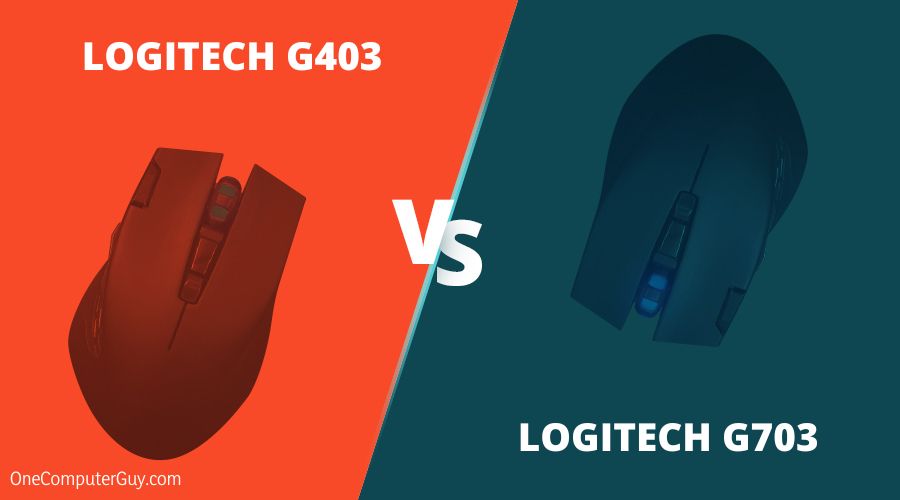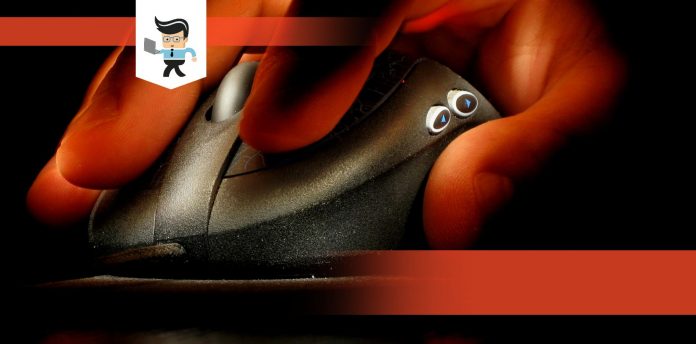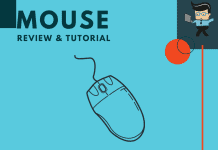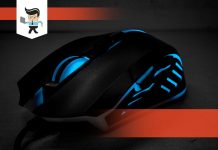Contents
Logitech G703 vs G403
When you compare the Logitech G703 vs the G403 is the best wireless mouse available on the market for right-handed people with medium or above average sized hands. It features a great shape, lagless wireless input and solid, clicky buttons, with good battery life.
 The G403 is a part of the new Prodigy line, which has a mission to make high-end gaming gear more approachable to the average consumer. By reducing the number of buttons and evoking a classic design, they hope to attract the casual player without sacrificing the hardcore gamers who make up a significant portion of their base. The G403 is the heart of these efforts, but it’s a long gamble to reach such a broad audience with a single product.
The G403 is a part of the new Prodigy line, which has a mission to make high-end gaming gear more approachable to the average consumer. By reducing the number of buttons and evoking a classic design, they hope to attract the casual player without sacrificing the hardcore gamers who make up a significant portion of their base. The G403 is the heart of these efforts, but it’s a long gamble to reach such a broad audience with a single product.
They’re almost exactly the same mouse, same shape and weight, same sensor. The only difference is that the G703 is capable of working with the Logitech Powerplay mousepad so it can charge wirelessly during use.
The G403 recharges through the USB cable only. If you don’t care about the ability for wireless charging, then get the G403 if you can find it for a lower price. It provides the same mouse experience, with slightly better clicks.
Comparison Table
| Mous | Key Specifications |
| Logitech G403 |
|
| Logitech G703 |
|
1. Logitech G403 review
Pros
- Fantastic wireless, lagless
- Best sensor on the market: Pixart PMW 3366
- Good battery life, 30 hours with RGB off
- Good weight considering the tech and size: 107 grams
- Great right handed ergonomic design
Cons
- Pricier than a wired mouse, you’re paying for wireless
- Wired G403 version has a thick braided cable
- Size of mouse might not be suited for smaller hands
Gaming mice are often defined by their exotic shapes, but the Prodigy line takes things back to basics. The classic design for the G403 that feels natural and familiar, with a slightly tapered grip where your thumb and ring finger rest on the mouse, it glides across most surfaces with ease. Its minimalistic design is more approachable than other popular gaming mice like the Razer Naga, which boasts 12 buttons and a more unconventional “ergonomic” shape for right handers.
The Logitech G403 just barely touches on modern gaming gear lighting and conventions by jazzing up its matte black finish with RGB LEDs under the G logo and the scroll wheel. Both these lighting areas are programmable in the Logitech Gaming Software. It’s understated and stylish without being over the top. You could use this mouse in the office and nobody would bat an eye.
The matte finish feels good in your hand, stays less sweaty than slick finishes, and doesn’t attract fingerprints. The two thumb-side buttons are positioned well, out of the way enough to avoid accidentally clicking them, but close enough to your thumb that they’re easy to press without reaching.
The two primary buttons feel sharp and snappy. They’re responsive and produce a satisfying click, and they’re quick enough for competitive gaming. Logitech proudly proclaim that the buttons are the same as on their Pro line of products, with custom-tensioned springs and detached plastic that will not warp over time.
Compare this to the unibody design on most Razer and Roccat mice, where the buttons are part of the plastic shell of the mouse and you will find over time, the unibody buttons can deform with repeated use.
However, it’s worth noting that the mouse has an unpleasant habit of buzzing at you if you tap it against a hard surface like a tabletop and if you pick it up and move it, it will buzz too. it’s just probably a side-effect of those custom tensioned springs underneath the right and left buttons.
We need to talk about the G403 weight because it was engineered to be light, so we can’t fault it for that but it has a tendency to feel cheap and plasticky, cheaper than its price tag would suggest. There’s a slot underneath for an optional weight, but even with the extra 10 grams, the G403 feels insubstantial.
– Lighting
Let’s talk about the lights. Ever since gamers started putting LEDs in computer cases, peripheral manufacturers have been catching up to them by adding customizable LEDs. The G403’s LEDs are bright, but muted to keep them from being too showy.
The RGB LEDs tend to have a blue hue if you change them to any color that strays too far from red, green, or blue. They can shift easily between the 16.8 million colors available, or you can program them to any color you’d like via Logitech Gaming Software. They look nice, if you like blue.
– Smooth performance
The sensor is the really standout feature of the G403. According to Logitech, the sensor sends 1000 reports per second, and it shows. The mouse is silky smooth even on the highest sensitivity settings.

The mouse’s sensitivity can be controlled with a button above the scroll wheel. Toggling between the three available presets, it’s hard to find a perfect setting that is just right, though. Each one is either too sensitive, or too slow. You can fix this easily by adjusting the sensitivity in your computer’s settings or individually for each game, but it would have been nice if the presets were a little more granular.
2. Logitech G703 review
– Tech Specs
Dimensions
Length: 12.4 cm
Width:6.8 cm
Height: 4.3 cm
Shape: Ergonomic
Weight: 107.2 grams
Cable: 1.8 metres, stiff braid
– Tech
Sensor: Pixart PMW3366
Buttons: Omron
Polling Rate: up to 1000 Hz
DPI: 200 to 16,000
Buttons: 5 + DPI switcher
Software: Logitech Gaming Software
Connectivity: Wired and Wireless
G703 Battery Life: 30 hours (RGB off), 22 hours (RGB on), 60 hours (RGB off) for G703 HERO
Recharge time: approx 2 hours, wireless charging option with Powerplay
The G703 dimensions are 12.4cm in length, 6.8cm in width and 4.3 cm in height, making it one of the taller mice on the market while also being fairly wide and long, it definitely falls in the large mouse category.
Despite its large size, the right handed ergonomic design works well to suit medium/large hands in all grip types but particularly shines with a palm grip, as a claw grip might be difficult for people with smaller hands. This is Logitech’s version of the traditional righty ergonomic mouse, and it should be instantly familiar as an approachable gaming mouse.
The 6.8cm width is consistent throughout the mouse with the height of the mouse being at its highest point a few centimeters past the heel, then sloping gently near the front of the mouse. The G703 has an extremely comfortable shape. This mouse is pretty much perfectly suited for a palm grip, so if you have a palm grip then this should be a mouse you look at no question. The balance of the mouse sits a bit further back to its hump coming in closer to the rear.
The top of the mouse is coated in a matte finish which resists fingerprints, with subtle rubber grips running down the entire length of the sides of the mouse, it feels like a premium mouse with premium materials. No obvious rattles in the mouse when shook, unlike the buzzing of the G403, and the scroll wheel stays firmly in place.
The Logitech G703 weight comes in at 107.2 grams, not bad for a large mouse and especially good for wireless large mouse, the HERO edition shaves off about 10 grams coming in at 95 grams. The shape, weight and the Pixart PMW3366 sensor makes the Logitech G703 an overachiever in terms of performance.
If you haven’t read any of the other reviews, the PMW3366 is a flawless sensor which means no spinning out, no acceleration and you can assure 1:1 input with a range of DPI tracking. Lift off distance is low and Logitech’s software allows for surface tuning to avoid any mistracks. You’re getting a top-tier sensor and tracking from the Logitech G703.
The wireless of the G703 is what sets it apart from other models, and I’d recommend you skip the wired version of the G703/G403 entirely and get the wireless version if you can.
Removing the drag from that Logitech cable is a huge advantage. But more importantly, the wireless on the Logitech mice are lag-free, so for the most part, they are indistinguishable from a wired mouse.
– Buttons & Scroll Wheel
The Logitech G703 is a standard 5 button mouse with two primary clicks, two side buttons, a scroll click and a DPI button on the top of the mouse right underneath the scroll wheel. Underneath, the wireless version of the G703 has a power switch.
The G703 features Omron switches rated for 50 million clicks, they’re solid clicks but it feels like the G703 is tuned a little softer in comparison to the G403. When compared to other mice, the clicks of the G703 fall in the mid-range in terms of tactility, behind the Zowie mice, Logitech G Pro and Rival 600 but much crisper than the Razer DeathAdder.
The side buttons are nice and large, easy to reach, they have a satisfying travel and a good click to them. They aren’t really anything to write home about, but they are effective side buttons.
The scroll wheel has a reasonable tactility while maintaining pretty much silent operation, but the middle click is a little mushy in comparison to some other mice, even when compared to the G403, it gets the job done, but if you really like scroll wheel clicks over a smooth scroll wheel this might not be the mouse for you.
In general, the G703 is going to excel, it’s a fantastic mouse for general use and light gaming, there’s nothing lacking in the buttons or shape of the mouse. Playing a couple of hours of DOTA 2 are just as comfortable as playing a bunch of Overwatch.
– Features & Software
All the standard Logitech features are present in the G703:
- Surface tuning
- RGB lighting settings
- DPI stepping
- Saved profiles on the mouse
- Button remapping
- Input analysis
- Macro recording
The RGB of the mouse is limited to a ‘G’ logo on the arch of the G703 with an RGB strip inside the scroll wheel. You get all the standard settings with rainbow cycling, breathing or fixed color.
In the wireless version of the G703 (which is the one you should get), the RGB strip in the scroll wheel also acts as a power meter anytime you wake or turn on the G703.
The biggest feature of this mouse is obviously the lagless wireless, the G703 has a pretty good battery life at a max of 30 hours of active time, up or down depending on how much RGB you use. When not in use the G703 sleeps well, very little battery drain, if you were to use this mouse as a daily driver for an 8 hour work day it should last you 3 days.
When it does need a charge Logitech has backed in a braided charging cable the plugs into the front of the mouse where the G703 will still be usable in wired mode while charging. I don’t feel any limitations with Logitech’s wireless implementation here, the mouse is always available and pretty much always wireless.
If you don’t want to ever plug in your mouse, then you should get the Logitech Powerplay mouse pad. This mouse pad allows the G703 to be trickle charged constantly, meaning your mouse never loses charge.

This feature comes at quite the cost, for me, the cable charging is more than enough, and if you feel you’re plugging in too often then consider getting the mouse pad.
Conclusion
The Logitech G403 and G703 are very similar mice. They have the same form factor, the same sensor, and the same Logitech features. The main difference between Logitech G403 and G703 is, the G403 must be charged through the USB cable and the G703 has the option of using the PowerPlay mouse pad which constantly charges the wireless mouse and means you never need to plug it in.
If you don’t really care about the wireless charging ability, then you should get the G403 wireless because it is a lower price than the G703 for virtually the same mouse. If the idea of a wireless mouse that you never have to plug in or change batteries in ever again sounds like your dream, then get the G703 and spend the extra $ on the specialized mouse mat.







